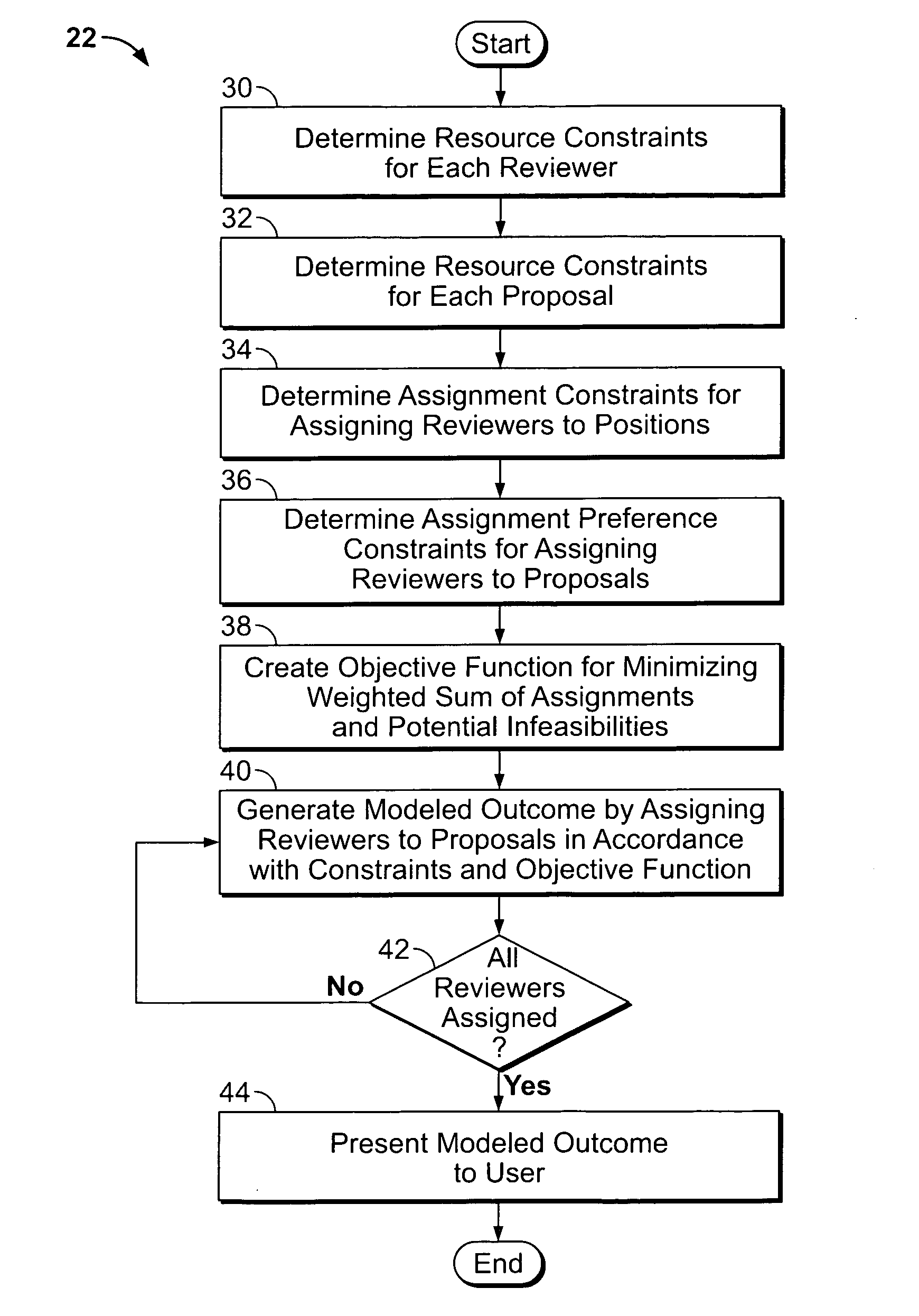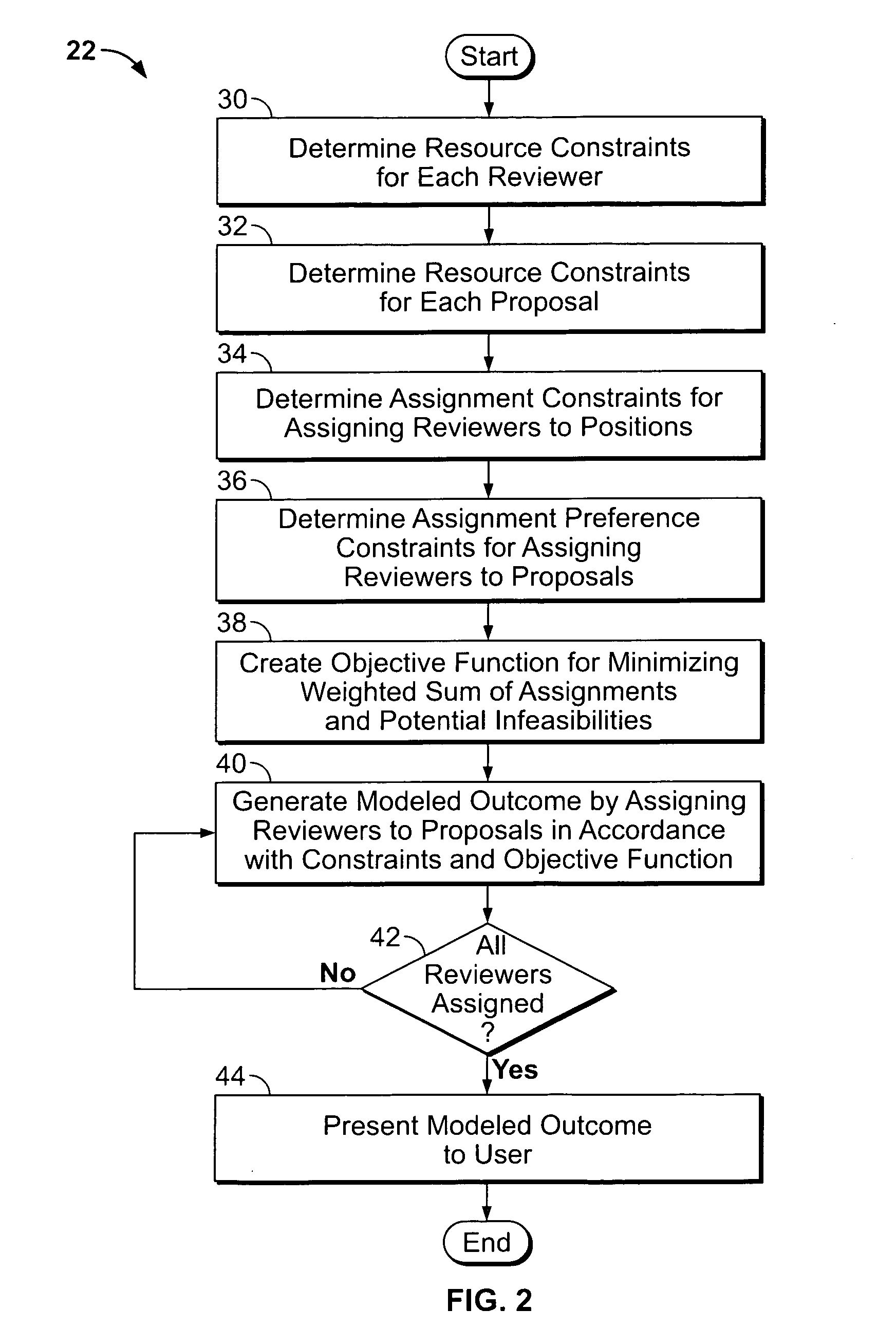System and method for optimally assigning groups of individuals to tasks
a technology of optimal assignment and task, applied in the field of optimal assignment of task groups, can solve the problems of inability to adequately take into account preference-based constraints, inability to flexibly model assignment problems to optimality, and inability to adapt existing approaches to model assignment problems
- Summary
- Abstract
- Description
- Claims
- Application Information
AI Technical Summary
Benefits of technology
Problems solved by technology
Method used
Image
Examples
example 1
[0070] The present invention was tested using a simple panel assignment problem involving 10 reviewers to be assigned to 24 proposals so that each proposal is reviewed exactly 3 times. Thus, N=24, M=10, and K=3. The preference criteria matrix for each reviewer on each proposal is shown in FIG. 3. The values for the preference criteria matrix could be expressed as integers on an ascending preference scale from 1 to n, where n could represent the highest proposal number. Such values could be repeated as desired by the user. Any other suitable scale and associated values could be implemented (e.g., values 1 through 10) without departing from the spirit or scope of the present invention.
[0071] The optimal solution has an objective function value of 329, and the assignments generated by the present invention are shown in FIG. 4. Note that each reviewer is assigned to 7 or 8 proposals, and is assigned to be the LEAD (L), the SCRIBE (S), and the REV1 (R1) either 2 or 3 times each. In addi...
example 2
[0073] The present invention was tested using an instance of the panel assignment problem which cannot satisfy the preference constraints for reviewers to proposals and thus must introduce infeasibilities (i.e., sl(i,j,jj)) into the solution. Thus, if the slack variables are not included, then the problem is infeasible. This example involves 5 reviewers that must be assigned to 10 proposals so that each proposal is reviewed exactly 4 times. Thus, N=10, M=5, and K=4. The preference criteria matrix for each reviewer on each proposal is shown in FIG.7.
[0074] The optimal solution using α=1000 has an objective function value of 5188 where the first term in the objective has a value of 188. The assignments and infeasibilities are shown in FIG. 8. Note that each reviewer is assigned to 8 proposals and is assigned to be the LEAD (L), the SCRIBE (S), the REV1 (R1), and the REV2 (R2) exactly 2 times each. However, these assignments are made by introducing infeasibilities into the preference ...
example 3
[0075] The present invention was tested using a larger panel assignment problem which involves 20 reviewers that must be assigned to 50 proposals, such that each proposal is reviewed exactly 3 times. Thus, N=50, M=20, and K=3. The preference criteria matrix for each reviewer on each proposal is generated randomly so that each reviewer has 2 conflicts of interest and gives preferences for 25 proposals from 1 to 25. Then, the other 23 proposals are given a worst-case value of 50. Four different, randomly-generated preference criteria were considered, and each was solved with both the original model and the reformulated model to produce ten integer solutions. The model and solution statistics for this example are shown in FIG. 9. The optimal objective function varies between each randomly-generated preference criteria and the required computational effort is situation- and model-dependent. However, the problem is still solvable to optimality in a reasonable amount of time.
PUM
 Login to View More
Login to View More Abstract
Description
Claims
Application Information
 Login to View More
Login to View More - R&D
- Intellectual Property
- Life Sciences
- Materials
- Tech Scout
- Unparalleled Data Quality
- Higher Quality Content
- 60% Fewer Hallucinations
Browse by: Latest US Patents, China's latest patents, Technical Efficacy Thesaurus, Application Domain, Technology Topic, Popular Technical Reports.
© 2025 PatSnap. All rights reserved.Legal|Privacy policy|Modern Slavery Act Transparency Statement|Sitemap|About US| Contact US: help@patsnap.com



